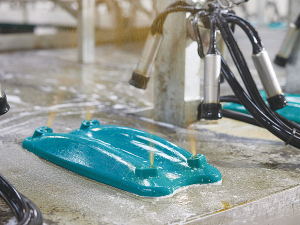GEA launches AI-powered walkover teat sprayer
GEA says that its latest walkover teat sprayer is helping farmers save time and boost udder health.
 GEA claims its new automatic teat spraying system helps reduce somatic cell count and improve teat condition.
GEA claims its new automatic teat spraying system helps reduce somatic cell count and improve teat condition.
Automatic teat spraying is no longer just about labour savings, says dairy automation company GEA.
The company claims its new on-platform teat sprayer, the iSPRAY4, offers unrivalled teat care.
Already, the system has proven to reduce somatic cell count (SCC) and improve teat condition, it says.
Taranaki dairy farmer Andrew Pritchard says the iSPRAY4 is a gamechanger. Eighteen months ago he installed a 50-bail iFlow Rotary Platform, a one-person operation milking 460 cows.
Initially, he was working with the old model 2-nozzel iPUD automatic teat sprayers.
"I was never happy with coverage (of the teats), the leg spreading ability or hygiene - it was hard to keep clean.
"The new 4-nozzle (iSPRAY4) has been an exceptionally good change.
"The design makes it easy to cup, with the cups hanging better. The leg spreader caters for big and small cows, and there's a bigger range of coverage with the 4 nozzles.
"Our cell count has dropped since the day it was installed and teat condition is the best it has ever been."
The farm's SCC season average has gone from 150,000 to 90,000.
According to GEA Product Manager Ben Morris, the new iSPRAY4 sees the iPUD redesigned to target full barrel coverage.
"Installing the iSPRAY4 will see farmers taking a big step forward in terms of teat-spraying accuracy and better efficiency in the milking process," says Morris.
Designed with 8 nozzles, the iSPRAY4 offers 4 post-spray nozzles which apply teat spray using crossfire technology for full coverage.
Although not yet adopted in New Zealand, there are also 4 pre-spray teat nozzles in each unit. The leg separating capacity results in great cluster alignment.
A deep groove through the centre ensures the cluster and milk tubes hang freely for an unobstructed milking routine for all cows, while the units are much easier to clean-down.
GEA says combining this system with its FIL Intelliblend creates further labour savings and better consistency, automating the mixing of teat spray concentrates and delivering programmed ratios to the spray units.
Pritchard says with Intelliblend added, we don’t have to do anything.
“From concentrate to spraying, it’s all taken care of. It provides consistency and reliability,” he says.
GEA says the iSPRAY4 (and Intelliblend) is a simple to install ‘plugand- play’ solution for any rotary platform.
Because the system has proven to perform best with FIL teat spray products, GEA is offering to extend the standard 1-year warranty to a 3-year warranty for any farmers who purchase the units with a 3-year FIL teat spray supply commitment.
A New Zealand dairy industry leader believes the free trade deal announced with India delivers wins for the sector.
The Coalition Government will need the support of at least one opposition party to ratify the free trade deal with India.
Primary sector leaders have welcomed the announcement of a Free Trade Agreement between India and New Zealand.
At Pāmu’s Kepler Farm in Manapouri, mating has wrapped up at the across-breed Beef Progeny Test.
More than 150 people turned up at Parliament recently to celebrate the 20th anniversary of Horticulture New Zealand (HortNZ).
Biosecurity New Zealand says Kiwis should continue to keep an eye out for yellow-legged hornets (Vespa velutina) over the holiday season.
President Donald Trump’s decision to impose tariffs on imports into the US is doing good things for global trade, according…
Seen a giant cheese roll rolling along Southland’s roads?